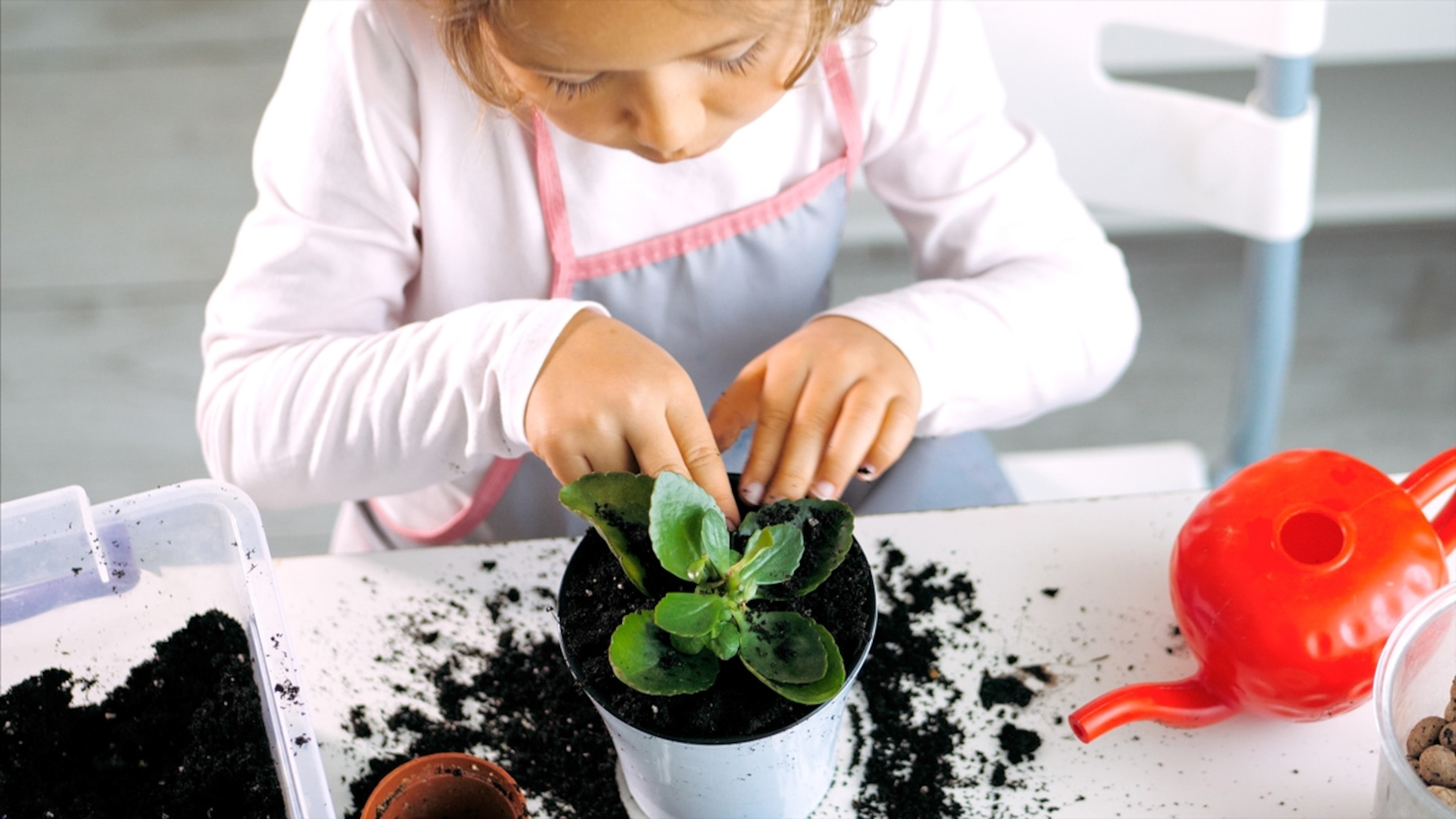
Help your kids grow an eco-friendly indoor garden
Garden-based learning can have positive impacts on children. Here’s how to get them started.
Sarah Pounders’ daughter started gardening when she was four with a collection of individual bean sprouts in clear plastic cups. But by the time she was 12, she decided to expand her skills and grow tomatoes indoors under a hydroponic light.
“To have that hands-on experience was so different than just talking about it,” says Pounders, senior education specialist at the nonprofit KidsGardening. “Taking care of the plant, measuring it, seeing the change—it’s a great, engaging way to learn.”
Gardening is especially meaningful when kids are involved. Numerous studies have found that gardening and garden-based learning have significant positive impacts on childhood development, including improved motor skills, better eating habits, and stress relief. Gardening might even help them become better science students.
“It also builds positive associations with nature, leading kids to be more likely to protect nature in the future,” says KidsGardening executive director Emily Shipman. “And it lets kids connect with the caregivers in their lives while doing these activities together.”
Getting kids involved
Not sure if your child is interested in gardening? Try tailoring activities to their interests.
Shannon Hill, a horticulturalist at Smithsonian Gardens in Washington, D.C., says her nine-year-old son loves drawing. So when they decided to grow a garden this year, he drew a map of what plants he wanted and how he wanted to lay them out. His five-year-old brother preferred the “dirty work” of prepping the soil and handling the seeds.
Involve kids from the very beginning, says Alexandra Thompson, also a horticulturalist at Smithsonian Gardens. “Take your kids to the store and give them a few options to pick from,” she says. “This will also allow you to pick plants that they can handle and are appropriate for your home conditions.”
She also suggests choosing a windowsill in a child’s bedroom to encourage them to take ownership. Younger kids can be given simple projects, like misting plants or plucking off yellow and brown leaves.
Above all, let children make mistakes. Although you might want to step in when you see your child dousing a plant with too much water, some of the most lasting lessons come from just trying things out. “I had a class that wanted to see what would happen if you planted pansy plants upside down,” Pounders says. “I let them do that, and you know what? They learned a lot!”
Picking the perfect plant
To make sure your garden is a success, assess both your home environment and your family’s attention span. “Do your research first,” Thompson says. “Don’t just pick up a plant because you like how it looks or the price is right.”
Think about your goal: Growing something tasty? Finding a fool-proof plant? Filling your home with flowers? Then consider these options for your budding gardeners:
Flowers grow well in window boxes and come in wide varieties to entice kids, who can choose plants in their favorite colors. Mary Pope, a master gardener at DC-based nursery and hardware store Logan Hardware, suggests planting bulbs in clear vases to allow children to see the roots grow. Pounders suggests the African violet, a hearty but beautiful flowering plant that does well indoors.
Veggies offer big rewards for kids who love to help in the kitchen, but make sure you have a decent amount of natural light available. Pope recommends lettuces or quick-growing sprouts as easy starting greens. Eat them as soon as they’re ready. “The kids enjoy their food that much more when they know they’ve played a part in planting, growing, harvesting, and preparing the food,” Hill says.
Herbs are easier to grow in lower light conditions, plus they smell great. For kids with short attention spans, chives and basil are good choices.
Houseplants are great if you’re looking for a plant that can survive, well, kids. Hill recommends sticking with heartier options, such as pothos, philodendrons, spider plants, and aglaonemas.
Making gardens eco-friendly
Another way to get kids excited about indoor gardening—and to raise lifelong nature lovers in the process—is to incorporate eco-friendly methods.
Reduce food waste with scrap gardening. “Seeds from over-ripe tomatoes or peppers can be saved and planted,” Hill says. “The bases of lettuce and celery stalks can be placed into trays of water, where new leaves and stalks can sprout. Potato ‘eyes’ can be planted and grow into potato plants. And this is just a short list!”
Use leftovers to nourish hungry plants. The water left after cooking rice or boiling eggs makes a great organic fertilizer, as do coffee grounds, Pope says. Similarly, banana peels can be steeped in water, which can then be used for watering smaller plants. “It helps the plants thrive, and it helps you cut down on waste,” she adds. If older kids are looking for more of a challenge, Thompson encourages teaching them how to compost.
Reuse household items as planters. Almost anything can be used as a planting vessel, from old food containers to tea tins to kids’ toys, says Courtney Belew, senior manager at Logan Hardware. Just understand what kind of drainage your plant will need, and make sure that your vessel will hold up in its environment. “For example,” she says, “a plastic bottle in front of a hot window or heater could leech materials or melt.”
Use natural ingredients. Belew notes that natural fertilizers such as worm castings or fish fertilizer can help you avoid harsh chemicals. Hill adds, “For pest control, you can use products from around the house, such as a soapy water solution or isopropyl alcohol.”




